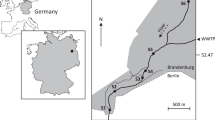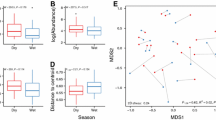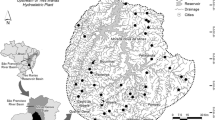Abstract
Emphasizing species’ trait similarities over differences, functional feeding guilds underrepresent functional diversity within stream communities. Species within guilds commonly overlap in their distributions and must partition their shared resources to coexist. Guild partitioning strategies may be revealed by the dissimilar responses the species show to environmental conditions, and these responses may be predicted from species-specific traits. To test this, I examined a grazer guild in a mountain stream dominated by three mayflies, Baetis, Epeorus, and Cinygmula. My objective was to determine how these species responded to gradients of current velocity, stream depth, and rock size and the abundance of algal food. I sampled 35 streambed locations and measured near-bed current velocity and depth at nine points at each location before sampling macroinvertebrates with a Surber sampler. Nine of the sampled rocks were measured for size, and benthic algae were collected from four of them. Multiple regression and non-metric multi-dimensional scaling (NMDS) revealed that each mayfly had unique responses to current velocity, depth, rock size, and algal abundance. Baetis correlated with depth, current velocity, and the interaction of these variables. Epeorus correlated exclusively with current velocity, and Cinygmula correlated with depth in interaction with other variables. Algal abundance by itself was a poor predictor of mayfly abundance, and NMDS indicated that individual species responses were not good predictors of mayfly assemblage patterns. Nevertheless, the mayflies’ idiosyncratic responses to current velocity, depth, and rock size supported the notion that these variables are components of unique partitioning strategies.


Similar content being viewed by others
References
Adler, P. B., A. Fajardo, A. R. Kleinhesselink & N. J. B. Kraft, 2013. Trait-based tests of coexistence mechanisms. Ecology Letters 16: 1294–1306.
Alvarez, M. & B. L. Peckarsky, 2005. How do grazers affect periphyton heterogeneity in streams? Oecologia 142: 576–587.
Ambühl, H., 1959. Die Bedeutung der Strömung als ökologischer Faktor. Schweizerische Zeitschrift für Hydrologie 21: 133–264.
Baumer, C., R. Pirow & R. J. Paul, 2000. Respiratory adaptations to running-water microhabitats in mayfly larvae Epeorus sylvicola and Ecdyonurus torrentis, Ephemeroptera. Physiological and Biochemical Zoology 73: 77–85.
Carlisle, D. M., S. M. Nelson & K. Eng, 2014. Macroinvertebrate community condition associated with the severity of streamflow alteration. River Research and Applications 30: 29–39.
Charles, D. F., C. Knowles & R. S. Davis, 2002. Protocols for the Analysis of Algal Samples Collected as Part of the U.S. Geological Survey National Water-Quality Assessment Program. The Academy of Natural Sciences, Philadelphia, PA.
Craig, D. A. & T. N. Kutash, 1999. Ontogenetic effects on locomotory gaits in nymphs of Baetis tricaudatus Dodds (Ephemeroptera: Baetidae). Journal of the North American Benthological Society 17: 475–488.
Cummins, K. W., 1973. Trophic relations of aquatic insects. Annual Review of Entomology 18: 183–206.
Díaz, S., A. Purvis, J. H. C. Cornelissen, G. M. Mace, M. J. Donoghue, R. M. Ewers, P. Jordano & W. D. Pearse, 2013. Functional traits, the phylogeny of function, and ecosystem service vulnerability. Ecology and Evolution 3: 2958–2975.
Ditsche, P., J. Michels, A. Kovalev, J. Koop & S. Gorb, 2014. More than just slippery: the impact of biofilm on the attachment of non-sessile freshwater mayfly larvae. Journal of the Royal Society Interface 11: 20130989.
Ditsche-Kuru, P. & J. H. E. Koop, 2009. New insights into a life in current: do the gill lamellae of Epeorus assimilis and Iron alpicola larvae (Ephemeroptera: Heptageniidae) function as a sucker or as friction pads? Aquatic Insects 31: 495–506.
Douglas, M. & P. S. Lake, 1994. Species richness of stream stones – an investigation of the mechanisms generating the species-area relationship. Oikos 69: 387–396.
Dunson, W. A. & J. Travis, 1991. The role of abiotic factors in community organization. American Naturalist 138: 1067–1091.
Hawkins, C. P. & J. A. Macmahon, 1989. Guilds – the multiple meanings of a concept. Annual Review of Entomology 34: 423–451.
Heino, J., P. Louhi & T. Muotka, 2004. Identifying the scales of variability in stream macroinvertebrate abundance, functional composition and assemblage structure. Freshwater Biology 49: 1230–1239.
Hintz, W. D. & T. Wellnitz, 2013. Current velocity influences the facilitation and removal of algae by stream grazers. Aquatic Ecology 47: 235–244.
Hoffman, A. L., J. D. Olden, J. B. Monroe, N. L. Poff, T. Wellnitz & J. A. Wiens, 2006. Current velocity and habitat patchiness shape stream herbivore movement. Oikos 115: 358–368.
Holomuzki, J. R. & B. J. F. Biggs, 2006. Food limitation affects algivory and grazer performance for New Zealand stream macroinvertebrates. Hydrobiologia 561: 83–94.
Jacobsen, D., 2005. Temporally variable macroinvertebrate-stone relationships in streams. Hydrobiologia 544: 201–214.
Kohler, S. L., 1984. Search mechanism of a stream grazer in patchy environments: the role of food abundance. Oecologia 62: 209–218.
McCafferty, W. P., R. S. Durfee & B. C. Kondratieff, 1993. Colorado mayflies (Ephemeroptera) – an annotated inventory. Southwestern Naturalist 38: 252–274.
Merritt, R. W., K. W. Cummins & M. B. Berg, 2008. An Introduction to the Aquatic Insects of North America, 4th ed. Kendall Hunt Publishing, Dubuque, IA.
Needham, P. R. & R. L. Usinger, 1956. Variability in the macrofauna of a single riffle in Prosser Creek, California, as indicated by the Surber sampler. Hilgardia 24: 383–409.
Palmer, T. M., 1995. The influence of spatial heterogeneity on the behavior and growth of two herbivorous stream insects. Oecologia 104: 476–486.
Peckarsky, B. L., 1996. Alternative predator avoidance syndromes of stream-dwelling mayfly larvae. Ecology 77: 1888–1905.
Peckarsky, B. L., S. I. Dodson & D. J. Conklin, 1985. A Key to the Aquatic Insects of Streams in the Vicinity of the Rocky Mountain Biological Laboratory Including Chironomid Larvae from Streams and Ponds. Colorado Division of Wildlife, Crested Butte, CO.
Petrin, Z., 2011. Species traits predict assembly of mayfly and stonefly communities along pH gradients. Oecologia 167: 513–524.
Poff, N. L., T. Wellnitz & J. B. Monroe, 2003. Redundancy among three herbivorous insects across an experimental current velocity gradient. Oecologia 134: 262–269.
Poff, N. L., J. D. Olden, N. K. M. Vieira, D. S. Finn, M. P. Simmons & B. C. Kondratieff, 2006. Functional trait niches of North American lotic insects: traits-based ecological applications in light of phylogenetic relationships. Journal of the North American Benthological Society 25: 730–755.
Principe, R. E., G. B. Raffaini, C. M. Gualdoni, A. M. Oberto & M. C. Corighano, 2007. Do hydraulic units define macroinvertebrate assemblages in mountain streams of central Argentina? Limnologica 37: 323–336.
Rader, R. B., 1997. A functional classification of the drift: traits that influence invertebrate availability to salmonids. Canadian Journal of Fisheries and Aquatic Sciences 54: 1211–1234.
Richards, C. & G. W. Minshall, 1988. The influence of periphyton abundance on Baetis bicaudatus distribution and colonization in a small stream. Journal of the North American Benthological Society 7: 77–86.
Simberloff, D. & T. Dayan, 1991. The guild concept and the structure of ecological communities. Annual Review of Ecology and Systematics 22: 115–143.
Steinman, A. D., 1996. Effects of grazers on freshwater benthic algae. In Stevenson, J. R., M. I. Bothwell & R. L. Lowe (eds), Algal Ecology: Freshwater Benthic Ecosystems. Academic Press Inc., San Diego: 341–366.
Stoaks, R. D. & B. C. Kondratieff, 2014. The aquatic macroinvertebrates of a first order Colorado, U.S.A. Front Range stream: what could the biodiversity have been before irrigated agriculture? Journal of the Kansas Entomological Society 87: 47–65.
Tomanova, S., P. A. Tedesco, M. Campero, P. A. Van Damme, N. Moya & T. Oberdorff, 2007. Longitudinal and altitudinal changes of macroinvertebrate functional feeding groups in neotropical streams: a test of the River Continuum Concept. Fundamental and Applied Limnology 170: 233–241.
Vaughn, C. C., 2010. Biodiversity losses and ecosystem function in freshwaters: emerging conclusions and research directions. Bioscience 60: 25–35.
Vaughn, C. C., D. E. Spooner & H. S. Galbraith, 2007. Context-dependent species identity effects within a functional group of filter-feeding bivalves. Ecology 88: 1654–1662.
Ward, J. V., 1975. Bottom fauna-substrate relationships in a northern Colorado trout stream: 1945 and 1974. Ecology 56: 1429–1434.
Weissenberger, J., H. C. Spatz, A. Emanns & J. Schwoerbel, 1991. Measurement of lift and drag forces in the mN range experienced by benthic arthropods at flow velocities below 1.2 m s−1. Freshwater Biology 25: 21–31.
Wellnitz, T., 2014. Can current velocity mediate trophic cascades in a mountain stream? Freshwater Biology 59: 2245–2255.
Wellnitz, T. & N. L. Poff, 2001. Functional redundancy in heterogeneous environments: implications for conservation. Ecology Letters 4: 177–179.
Wellnitz, T. & N. L. Poff, 2006. Herbivory, current velocity and algal regrowth: how does periphyton grow when the grazers have gone? Freshwater Biology 51: 2114–2123.
Wellnitz, T. & N. L. Poff, 2012. Current-mediated periphytic structure modifies grazer interactions and algal removal. Aquatic Ecology 46: 521–530.
Wellnitz, T. A., N. L. Poff, G. Cosyleon & B. Steury, 2001. Current velocity and spatial scale as determinants of the distribution and abundance of two rheophilic herbivorous insects. Landscape Ecology 16: 111–120.
Wolman, G. M., 1954. A method of sampling coarse river-bed material. Eos, Transactions American Geophysical Union 35: 951–956.
Acknowledgments
I thank the Rocky Mountain Biological Laboratory for logistical support and providing access to Copper Creek. Marge Penton identified the algal samples and did the cell biovolume estimates, undergraduate Nicholas Schoenfuss provided assistance in the lab and field, William Hintz commented on an early draft of the manuscript, and Barbara Tumm proofread the final draft. I thank them all. This research was funded by National Science Foundation grant (CAREER DEB-0642512), and support for Nick Schoenfuss was provided by the University of Wisconsin—Eau Claire’s Office of Research and Sponsored Programs.
Author information
Authors and Affiliations
Corresponding author
Additional information
Handling editor: Sonja Stendera
Rights and permissions
About this article
Cite this article
Wellnitz, T. How do stream grazers partition their benthic habitat?. Hydrobiologia 760, 197–204 (2015). https://doi.org/10.1007/s10750-015-2326-x
Received:
Revised:
Accepted:
Published:
Issue Date:
DOI: https://doi.org/10.1007/s10750-015-2326-x




